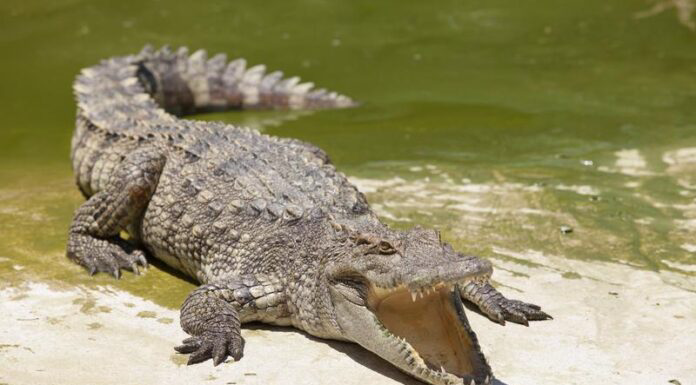An 80-year-old man from Indonesia was fatally attacked by a 10-foot crocodile while bathing in a river near his home in Tanggamus Regency, Lampung Province, Sumatra, on June 30, 2025. Identified only as Wasim, the elderly man was pulled underwater by the crocodile and could not call for help.
The incident was discovered when a 40-year-old villager named Yusron found Wasim’s clothes on the riverbank, but no sign of him. Yusron alerted other villagers, who then searched the river and saw the crocodile dragging Wasim’s body.
Villagers armed with sticks pursued the crocodile along the Semaka River banks to save Wasim. They entered the shallow water and struck the crocodile repeatedly until it released the victim.
Semaka Police Chief AKP Sutarto reported that Wasim was located within an hour, around 1:00 p.m. Western Indonesia Time, when the crocodile surfaced carrying him. Sutarto confirmed, “After being struck several times, the crocodile finally released the victim’s body,” but Wasim was deceased when recovered.
Wasim’s son-in-law, Samugi, stated that the day began typically with Wasim saying goodbye to his family before going to the river.
The police chief noted that Wasim had jagged wounds on his back, buttocks, and shoulders from the attack. His family accepted the cause of death, and the body was released for funeral arrangements. Police have urged locals to be more cautious during river activities to prevent future incidents.
The Indonesian archipelago is home to 14 crocodile species, including a large number of aggressive estuarine crocodiles that thrive in the region’s tropical climate. Conservationists link the rise in human-crocodile encounters to various environmental factors affecting the reptiles’ behavior.
Overfishing has depleted the crocodiles’ natural food sources, while habitat loss from the conversion of coastal areas to farmland has pushed the predators closer to human settlements. Extensive tin mining has also led to villagers encroaching on crocodile habitats, bringing these animals nearer to residential areas.
Some Indonesians continue to use rivers for bathing and primitive fishing, contributing to the increase in attacks. According to CrocAttack, an independent database, Indonesia recorded 179 crocodile attacks in 2024, the highest number globally, with 92 fatalities.
Since 1999, the saltwater crocodile has been protected under Indonesian law, prohibiting hunting. As apex predators, they face no natural population control, allowing growth in suitable habitats.
Crocodile handler Rusli Paraili, 39, expressed concern over the increasing attacks while working to mitigate the issue. He runs a farm in Budong-Budong, West Sulawesi, where he manages crocodiles away from human populations, with support from the government, community donations, and palm oil companies.
Paraili noted the rise in attacks on Sulawesi Island began about 12 years ago with palm oil plantation expansion near river mouths. Some companies created artificial waterways connecting to the Budong-Budong River, leading crocodiles to stray into residential areas, including fish and shrimp ponds.
Palm oil plantations now cover much of West Sulawesi from mountains to coast. Locals have incorporated crocodile patrols into daily routines, using flashlights to check water pumps and scan canals and waterways. This reflects the new reality of coexisting with these predators in areas where human development meets natural habitats.
Social media has seen an increase in videos documenting crocodile sightings and attacks in Indonesia, highlighting the growing interaction between humans and these protected predators throughout the archipelago.








